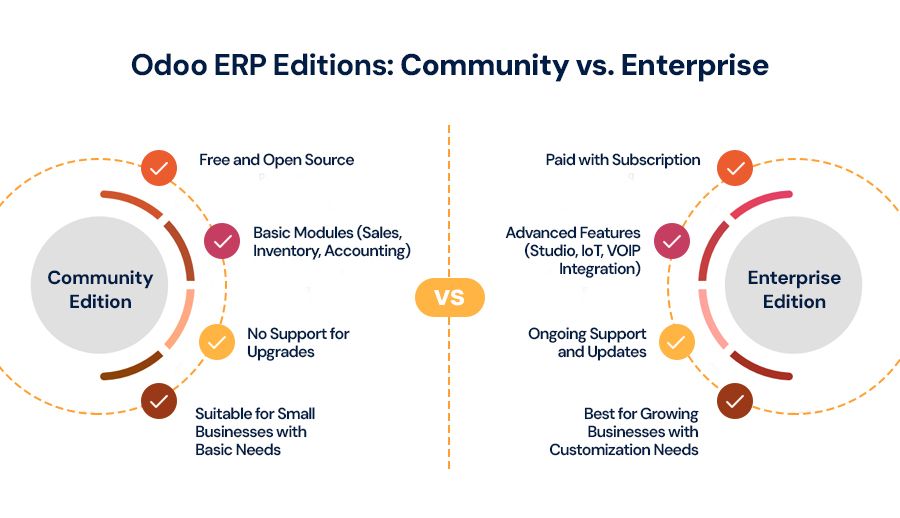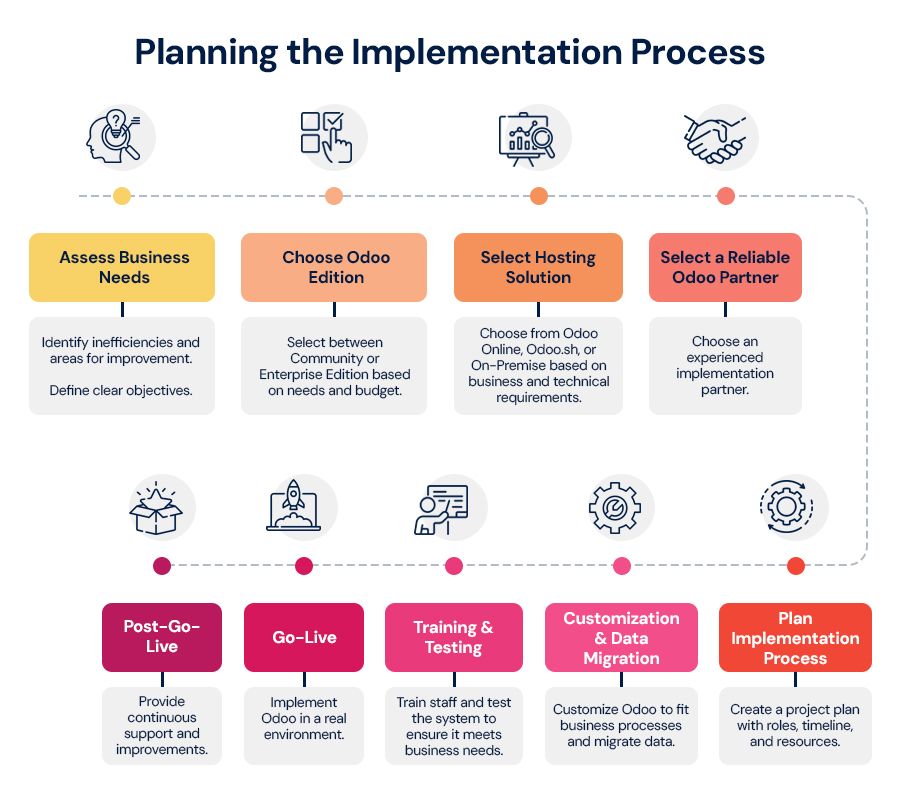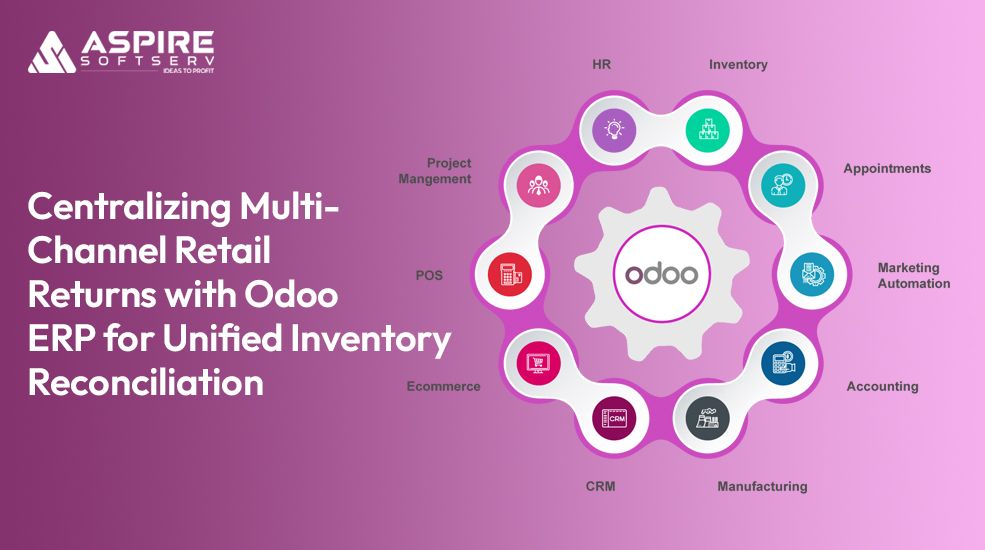
Implementing an ERP system like Odoo can be a profit gainer for SME businesses. It improves efficiency, streamlines operations, and provides valuable insights into various business processes. However, the implementation process can seem difficult, especially for those new to ERP systems. This guide will walk you through the essential steps to successfully implement Odoo for your SME business.
Also, there are several types of hosting solutions Odoo provides :
Odoo Online:
Here, Odoo provides your own database, which will be managed by Odoo. However, the limitation here is that you cannot do customization that requires code.
Reference: Odoo Online
Odoo.Sh:
In Odoo.sh, you can create your own database, as well as customize it with code. Users will find an Odoo server with backend admin access where they can define the number of server sizes, workers, database backup space, GitHub configuration, etc.
Reference: Odoo.sh
On-premise:
For on-premise hosting, the user must purchase their own server, such as from Contabo, Digital Ocean, AWS, etc., and must install Odoo manually. For this, the user must have technical knowledge to set up Odoo and install the required libraries.
Reference: On-Premise
1. Understanding Your Business Needs
Before diving into the implementation, it’s important to understand your business needs and requirements. Odoo ERP software development offers a wide range of modules such as Sales, Inventory, Accounting, HR, Manufacturing, CRM, POS, Fleet management, and more. Identifying the specific areas where you need automation and improvement will help in choosing the right modules.
Conduct a Needs Assessment:
Analyze your current processes and pinpoint the inefficiencies, identifying areas that need improvement.
Set Clear Objectives:
Define your goals for implementing Odoo. Whether it's reducing manual work, improving customer service, increasing sales efficiency, or improving employee work efficiency and machinery usage, clarity in objectives will set the foundation for a successful Odoo implementation.
2. Choosing the Right Odoo Edition

Odoo comes in two editions: Community (free and open source) and Enterprise (paid with additional features). For small businesses, the Community edition might suffice, but if you need advanced features like Studio, IoT, or VOIP integration, WhatsApp integration, consider the Enterprise edition.
Evaluate Your Budget:
The Enterprise edition requires a subscription, so assess your budget to determine if the additional features are worth the investment. Additionally, the subscription cost will be user-based, meaning the price will depend on how many users you need to manage in Odoo.
Consider Future Growth:
If you plan to scale your business rapidly, investing in the Enterprise edition might be beneficial in the long run. The main benefit is that, if you ever need to upgrade your Odoo version, Odoo Enterprise provides support for database migration from the old version to the new one.
3. Selecting a Reliable Odoo Partner
Choosing the right implementation partner is crucial for the success of your business and project. An experienced Odoo development company can guide you through the implementation process, customize modules to fit your business, and provide ongoing support to ensure you achieve your requirements.
Check Experience and Expertise:
Ensure the partner has experience in implementing Odoo for businesses similar to yours. A knowledgeable partner will also understand your unique needs and suggest the best modules for your business.
Read Reviews and Case Studies:
Look for client testimonials and case studies to gauge the partner’s reliability and success rate. A well-established partner will have a portfolio of successful Odoo implementations.
4. Planning the Implementation Process

A well-structured process is key to a smooth Odoo implementation. This involves setting a timeline, allocating resources, and defining the roles of your team members and the implementation partner.
Develop a Project Plan:
Outline the stages of implementation, including data migration, customization, testing, training, and final implementation.
Assign Roles:
Ensure that everyone involved knows their responsibilities. Whether it's providing data, customizing modules, testing the system, or giving feedback, a clear division of roles will ensure a smooth process.
5. Customizing Odoo to Fit Your Business
One of the strengths of Odoo is its open-source nature and flexibility. You can customize the system to match your unique business processes. This might involve creating custom workflows, reports, or integrating with other systems you use.
Identify Customization Needs:
Determine which processes need customization and discuss them with your implementation partner. This is where Odoo customization services come into play, as you may need specific features designed to meet your business needs.
Test Customizations:
Before going live, thoroughly test all customizations to ensure they work as expected. It’s important to follow coding standards to avoid issues when the system is live.
6. Data Migration
Migrating your existing data to Odoo is a critical step. This includes customer information, product details, financial data, sales records, employee details, and more. It’s essential to ensure that the data is clean, accurate, and properly formatted before migration.
Prepare Data:
Organize and clean your data to ensure a smooth migration. The migration process will be much easier if your data is structured and error-free.
Use Odoo’s Tools:
Utilize Odoo’s built-in tools for data import, or seek help from your implementation partner for more complex migrations. Additionally, the Odoo development company you choose should be well-equipped to handle data migration effectively.
7. Training Your Team
Even the best ERP system is only as good as the people using it. Training is essential to ensure that your team can effectively use Odoo’s features. Also, if you are customizing any workflows, then employees should be trained on those specific workflows; otherwise, those workflows may remain unused, and the system won't yield the expected results.
Provide Comprehensive Training:
Organize training sessions for different departments to ensure they understand how to use the relevant Odoo modules and functionality.
Create User Manuals:
Develop user manuals or guides tailored to your business processes for future reference. This ensures that employees can refer back to training materials if they have questions later.
8. Testing and Go-Live
Before fully transitioning to Odoo, it’s crucial to conduct thorough testing. This will help identify any issues or bugs that need fixing before the system goes live.
Conduct User Acceptance Testing (UAT):
Involve end-users in testing to ensure the system meets their needs and works as expected. End-users should have the opportunity to test all workflows and functionalities to ensure the system is user-friendly.
Prepare for Go-Live:
Plan the go-live date carefully, ensuring minimal disruption to your business operations. A well-planned transition will ensure that your employees can start using Odoo effectively right from the first day.
9. Post-Implementation Support
The implementation doesn’t end at go-live. Post-implementation support is essential to address any issues that arise and to optimize the system as your business grows.
Monitor Performance:
Keep track of how the system is performing and gather feedback from users. Regular monitoring helps to spot any issues early.
Plan for Continuous Improvement:
Regularly review your processes and consider further customizations or module additions to enhance efficiency. Ongoing improvements are a key part of ensuring Odoo continues to meet the evolving needs of your business.
Conclusion
Implementing Odoo for a small business can seem challenging, but with the right approach, it can significantly enhance your operations. By understanding your needs, choosing the right partner, and following a structured implementation process, you can successfully deploy Odoo and start reaping the benefits. The flexibility of Odoo ERP software development and the ability to customize it to your needs makes it a powerful tool for SMEs looking to streamline operations and improve efficiency.
Make Your Business Operations Easy with Odoo ERP!



